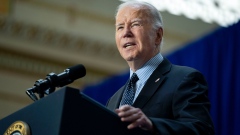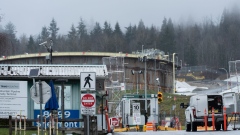Dec 10, 2020
Ontario COVID-19 cases rising; vaccinations to start next week
, The Canadian Press
Not clear if Pfizer's vaccine prevents those treated from infecting others: University Health Network CEO
TORONTO - Ontario could see 2,500 daily cases of COVID-19 by the end of the month if the virus keeps spreading at the current rate, the province's top doctor said Thursday, telling residents they needed to heed calls to stay home in order to curb rising infections.
If the growth rate accelerates from the current 1.5 per cent to five per cent, Ontario could see up to 10,000 cases a day by the first week of January, new projections showed.
The figures were released hours after the government announced it would begin administering COVID-19 vaccines on Tuesday at hospitals in Toronto and Ottawa.
Chief Medical Officer of Health Dr. David Williams said data indicated residents were not heeding calls to cut non-essential travel as much as they did during the province's first shutdown in the spring.
He said people need to stay home as much as possible, especially as the holidays approach, if Ontario is to be successful in fighting the virus.
“There's a lot of people out there on the move,” said Williams. “We have got to get that down.”
The province reported a record 1,983 new cases of COVID-19 on Thursday, and 35 new deaths due to the virus.
That came as the province said Ontario will receive 6,000 doses of Pfizer's COVID-19 vaccine on Monday, with plans to start administering them Tuesday.
The University Health Network in Toronto and the Ottawa Hospital will give the first shots to health-care workers from long-term care homes and other high-risk settings, said retired Gen. Rick Hillier, who is leading Ontario's vaccine task force.
“We are going to come after people who are in most vulnerable circumstances and our health care workers first and get them vaccinated because the tragedy has been visited upon them most,” he said.
Hillier said the province anticipates it will receive 90,000 doses of the Pfizer vaccine by the end of December and will distribute it to 13 hospitals across Ontario.
He said Ontario may also receive between 30,000 and 85,000 doses of the Moderna vaccine by the new year, provided it is approved by Health Canada in the coming weeks.
The government's latest virus projections, however, painted a grim picture of the weeks ahead.
Hospital intensive care unit occupancy will continue to rise above 200 beds for the next month, particularly if public health interventions are relaxed. That means elective surgeries and non-urgent procedures could be cancelled.
Deaths in long-term care continue to increase, with 496 since Aug. 1, and 102 over the past week. More deaths in the sector are expected.
Dr. Adalsteinn Brown, one of the experts behind the projections, said the virus' growth rate is fluctuating around one to one and a half per cent, which means that Ontario is at a “critical juncture”.
Even if Ontario limits the growth rate of the virus to zero per cent, the province will still see around 2,000 cases daily by the end of the month. If growth accelerates to five per cent, Ontario will see 10,000 cases a day by the first week of January.
“It's really important to understand that at this point, where the reproduction number is fluctuating around one, small changes, even just in a little bit of time, can lead to substantial growth,” Brown said.
Williams cautioned that any relaxation of public health measures would likely lead to increased case growth.
He said he will recommend additional restrictions for some regions, which will likely be announced Friday.
“We're in a very precarious stage here and we have to really watch carefully if we are not going to have to close some things further,” he said.
In the Windsor, Ont., area, the local public health unit announced Thursday that all schools would be closed starting on Monday due to rising rates of COVID-19.
Meanwhile, the province's fiscal watchdog warned that people in Ontario could face higher taxes or service cuts as municipalities face billions of dollars in COVID-19-related expenses.
Financial Accountability Officer Peter Weltman said the pandemic will cost Ontario municipalities $6.8 billion over two years.
He also warned that while the joint federal-provincial restart agreement inked earlier this year provided $4 billion in relief, and municipalities will find some savings, a $2.4-billion shortfall exists for the coming year.
Barring further intervention from upper levels of government, the costs will fall to local taxpayers, he said.
“Every municipality will be different, some will have more, some will have less, but nevertheless, there's still a gap,” Weltman said. “The only way to make that up for municipalities is either cutting services, or raising taxes.”
Municipal leaders have been calling for help from the provincial and federal governments to help with the funding shortage. Toronto Mayor John Tory called for a “Safe Restart 2.0” agreement for municipalities in a letter to Prime Minister Justin Trudeau and Premier Doug Ford.
Tory said Toronto is forecasting a $1.5-billion deficit by the end of 2021.
Municipal Affairs Minister Steve Clark said Thursday that municipalities will receive clarity on a second phase of funding before the end of the year.







